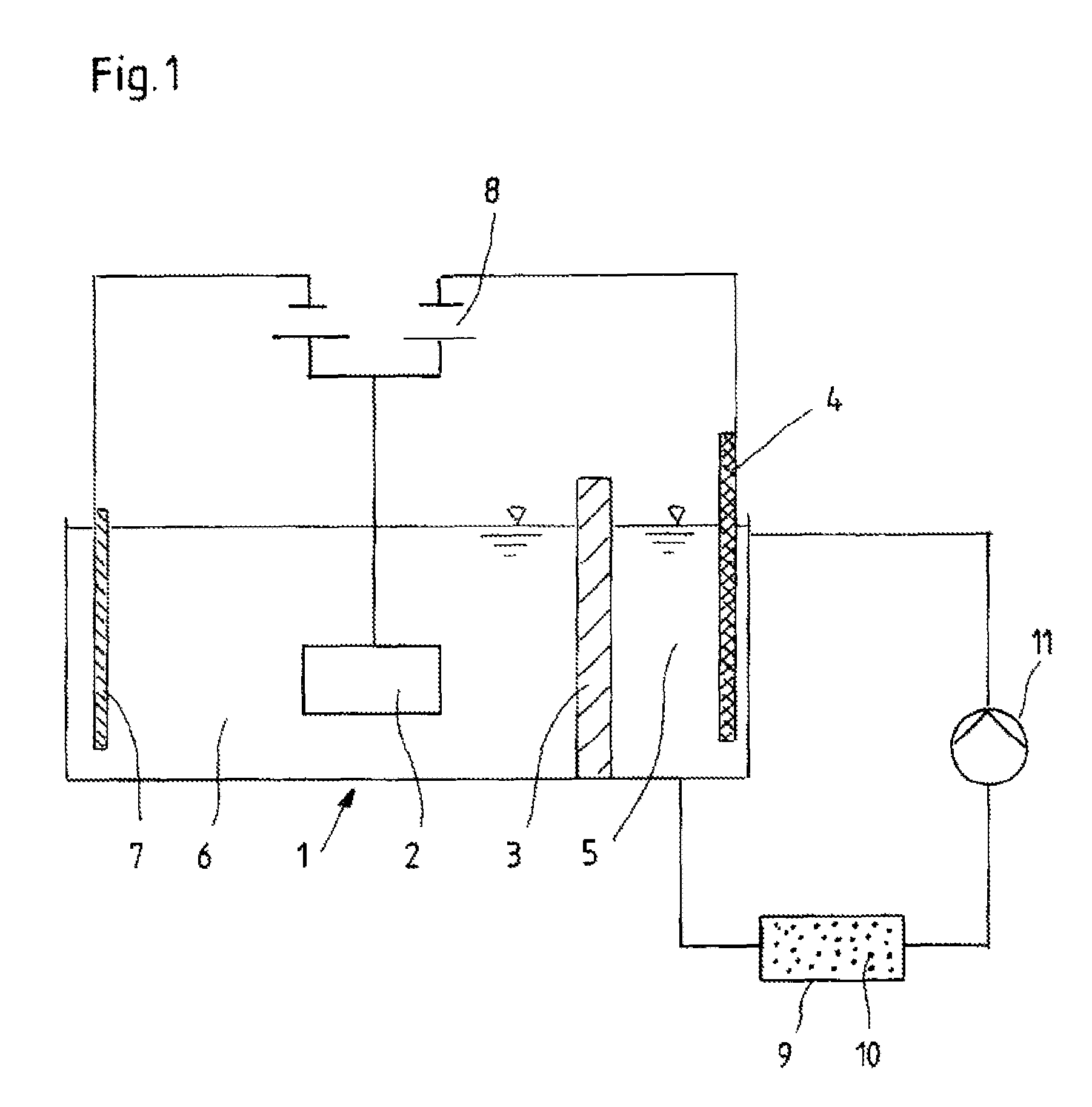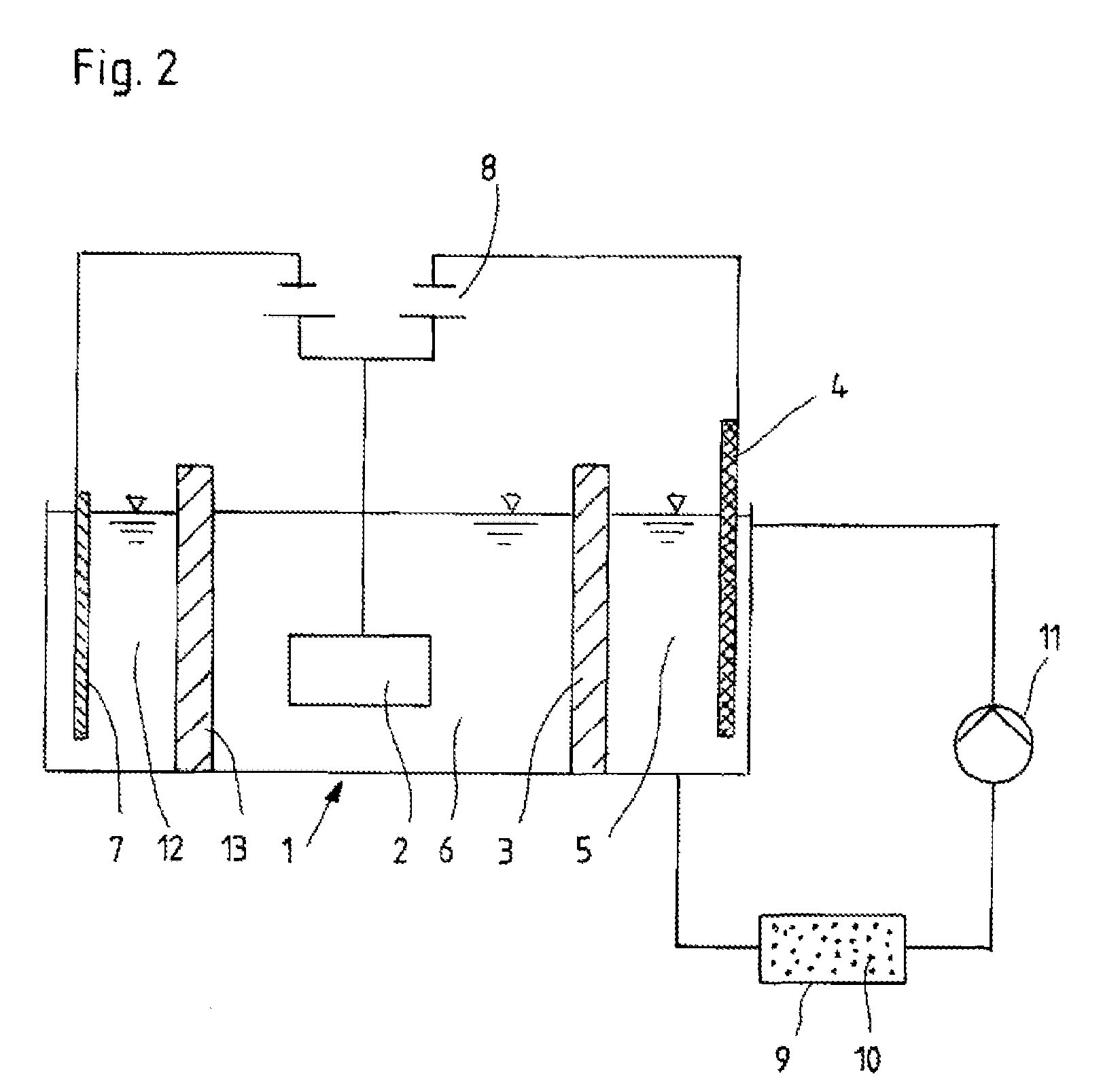Galvanic bath and process for depositing zinc-based layers
a zinc-based layer and galvanic bath technology, which is applied in the field of galvanic bath as well as a depositing method of zinc-bearing layers, can solve the problems of affecting the production cycle, passingivate, and affecting the properties obtained for the depositing of zinc-bearing layers, so as to avoid long-lasting contamination of anolytes with foreign metal ions and sufficient selectivity
- Summary
- Abstract
- Description
- Claims
- Application Information
AI Technical Summary
Benefits of technology
Problems solved by technology
Method used
Image
Examples
example 1
Deposition of a Zinc-Nickel Layer
[0027]In a galvanic bath according to the invention, as is reproduced in FIG. 1, a deposition electrolyte is introduced into the cell chamber 6, which contains 40-100 g / l of zinc chloride, 60-130 g / l of nickel chloride hexahydrate, 140-220 g / l of potassium chloride, 10-30 g / l of boric acid, 25 g / l of sodium acetate trihydrate, 30 g / l of aminoacetic acid, 2-12 g / l of sodium saccharine, 0.025-0.20 g / l of benzalacetone, 0.006-0.01 g / l of orthochlorobenzaldehyde, 0.8-1.2 g / l of octanolethoxylate, and 2.5-3.2 g / l of a potassium salt of sulfopropylated, polyalkoxylated naphthol. The pH of the electrolyte composition described here lies between 5 and 6.
[0028]Into the cell chamber 5 is filled an anolyte which includes 120 g / l of zinc chloride, 215 g / l of potassium chloride, and 20 g / l of boric acid. But the concentration of the components contained in the anolyte can be varied within the ranges of 80 and 500 g / l for zinc chloride, 150 to 300 g / l for potassiu...
example 2
Deposition of a Zinc-Nickel Layer
[0030]In a galvanic bath according to the invention, as is reproduced in FIG. 1, a deposition electrolyte is introduced into the cell chamber 6, which contains 40-100 g / l of zinc chloride, 60-130 g / l of nickel chloride hexahydrate, 140-220 g / l of potassium chloride, 10-30 g / l of boric acid, 25 g / l of sodium acetate trihydrate, 30 g / l of aminoacetic acid, 2-12 g / l of sodium saccharine, 0.025-0.20 g / l of benzalacetone, 0.006-0.01 g / l of orthochlorobenzaldehyde, 0.8-1.2 g / l of octanolethoxylate, and 2.5-3.2 g / l of a potassium salt of sulfopropylated, polyalkoxylated naphthol. The pH of the electrolyte composition described here lies between 5 and 6.
[0031]Into the cell chamber 5 is filled an anolyte which includes 120 g / l of zinc chloride, 215 g / l of potassium chloride, and 20 g / l of boric acid. But the concentration of the components contained in the anolyte can be varied within the ranges of 80 and 500 g / l for zinc chloride, 150 to 300 g / l for potassiu...
example 3
Deposition of a Zinc-Cobalt Layer
[0033]In a galvanic bath according to the invention, as is reproduced in FIG. 1, a deposition electrolyte is introduced into the cell chamber 6, which contains 60-70 g / l of zinc chloride, 100-130 g / l of cobalt chloride hexahydrate, 190-220 g / l of potassium chloride, 15-20 g / l of boric acid, 25 g / l of sodium acetate trihydrate, 30 g / l of aminoacetic acid, 2-12 g / l of sodium saccharine, 0.025-0.20 g / l of benzalacetone, 0.006-0.01 g / l of orthochlorobenzaldehyde, and 2.5-3.2 g / l of a potassium salt of sulfopropylated, polyalkoxylated naphthol. The pH of the electrolyte composition described here lies between 5 and 6.
[0034]An anolyte which consists of 250 g / l of zinc chloride, is contained in cell chamber 5. But the concentration of the zinc chloride contained in the anolyte can be varied within the range of 80 to 500 g / l of zinc chloride. Zinc pellets to be depleted are disposed in cell chamber 5 in an anode basket made of titanium, whereas a cobalt anod...
PUM
| Property | Measurement | Unit |
|---|---|---|
| voltage | aaaaa | aaaaa |
| concentration | aaaaa | aaaaa |
| concentration | aaaaa | aaaaa |
Abstract
Description
Claims
Application Information
 Login to View More
Login to View More - R&D
- Intellectual Property
- Life Sciences
- Materials
- Tech Scout
- Unparalleled Data Quality
- Higher Quality Content
- 60% Fewer Hallucinations
Browse by: Latest US Patents, China's latest patents, Technical Efficacy Thesaurus, Application Domain, Technology Topic, Popular Technical Reports.
© 2025 PatSnap. All rights reserved.Legal|Privacy policy|Modern Slavery Act Transparency Statement|Sitemap|About US| Contact US: help@patsnap.com



